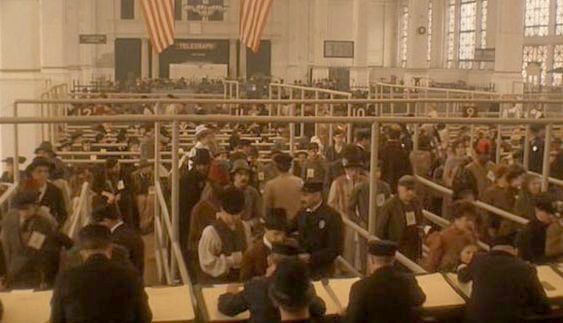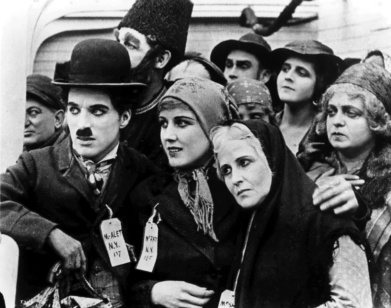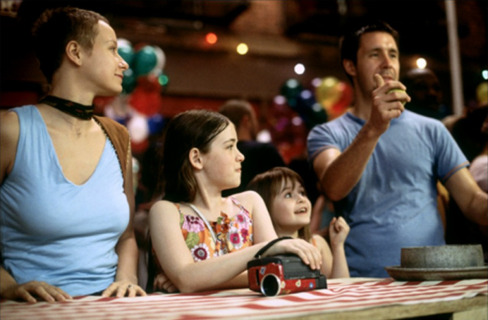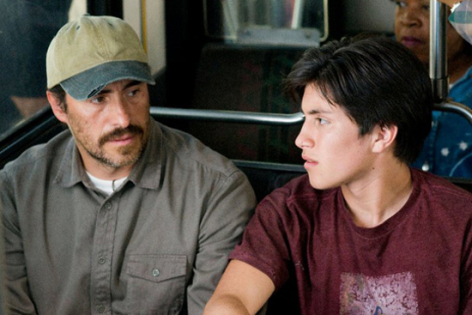 I admire the strength it must take to leave your home, your family, and your country to search and hope for a better life in a far away and foreign land. But it’s that hope for a better life that the American dream has always represented. From the British who left England to come to America in the 1600’s to today’s immigrants America has always been the land of hope and dreams. Sometimes it worked out; sometimes it did not.
I admire the strength it must take to leave your home, your family, and your country to search and hope for a better life in a far away and foreign land. But it’s that hope for a better life that the American dream has always represented. From the British who left England to come to America in the 1600’s to today’s immigrants America has always been the land of hope and dreams. Sometimes it worked out; sometimes it did not.
America is a country of immigrants, without them who would be here? We as a country have always welcomed immigrants. As John Lennon wrote and sang in his song, New York City, “the Statue of liberty said come.” Some of us seemed to have forgotten that today. Listed below are six films about the American immigrant experience.
The Immigrant (1917)
 Movies have traced the story of immigrants almost from the beginning of cinema. Charlie Chaplin’s 1917 short, The Immigrant, remains a poetic work that manages to combine romance, drama and a social conscience message about immigration and America. Chaplin was an immigrant himself, and much of what we see he draws from his own experience. The anticipation, the fears and the unknown. Visually, Chaplin drew inspiration from Alfred Stieglitz masterful photograph The Steerage which depicted the class separation on a ship bound from America back to Europe. In Chaplin’s film, there’s both a knowing hint foreshadowing what may lay ahead mixed with the Tramp’s rebellious humor. When one of the steerage class passengers spots the Statue of Liberty, Chaplin and the others gather around to look at America’s symbol of freedom. Suddenly, an immigration official shows up roping all the immigrants into one confined area. The immigrants are treated like cattle, pushed and shoved as their processing begins right on board the ship. When Chaplin’s turn comes, the official kicks him in the butt because he is not moving fast enough. Chaplin’s rebellious tramp gets his turn when the official turns his back on him.
Movies have traced the story of immigrants almost from the beginning of cinema. Charlie Chaplin’s 1917 short, The Immigrant, remains a poetic work that manages to combine romance, drama and a social conscience message about immigration and America. Chaplin was an immigrant himself, and much of what we see he draws from his own experience. The anticipation, the fears and the unknown. Visually, Chaplin drew inspiration from Alfred Stieglitz masterful photograph The Steerage which depicted the class separation on a ship bound from America back to Europe. In Chaplin’s film, there’s both a knowing hint foreshadowing what may lay ahead mixed with the Tramp’s rebellious humor. When one of the steerage class passengers spots the Statue of Liberty, Chaplin and the others gather around to look at America’s symbol of freedom. Suddenly, an immigration official shows up roping all the immigrants into one confined area. The immigrants are treated like cattle, pushed and shoved as their processing begins right on board the ship. When Chaplin’s turn comes, the official kicks him in the butt because he is not moving fast enough. Chaplin’s rebellious tramp gets his turn when the official turns his back on him.
The Emigrants (1971) and The New Land (1972)
 The great Swedish filmmaker, Jan Troell, made two compelling films about the immigrant experience. The Emigrants (1971) and The New Land (1972) depict the continuing story of a group of impoverished Swedish families, who like so many before and after, decided to leave their homeland where the land they work is hopeless and inhospitable. A class system and religious persecution add to the misery that life is not going to get better. They hear stories of how wonderful life is in America where everyone has plenty of food and money. The journey is cramped, rough, long and tedious; disease is rampant, and not all of the travelers make it. Once they land in America, like many immigrants later, they traveled to where they knew people, in this case, what is now Minnesota. The New Land picks up where the first film leaves off with life in America as they adjust to the good and the bad including the Civil War and Native American uprising. In life, there is good and bad. Though the films are Swedish, its story is one hundred percent American. What many of us forget is we all came from somewhere. It’s best to watch these films in the order they were made.
The great Swedish filmmaker, Jan Troell, made two compelling films about the immigrant experience. The Emigrants (1971) and The New Land (1972) depict the continuing story of a group of impoverished Swedish families, who like so many before and after, decided to leave their homeland where the land they work is hopeless and inhospitable. A class system and religious persecution add to the misery that life is not going to get better. They hear stories of how wonderful life is in America where everyone has plenty of food and money. The journey is cramped, rough, long and tedious; disease is rampant, and not all of the travelers make it. Once they land in America, like many immigrants later, they traveled to where they knew people, in this case, what is now Minnesota. The New Land picks up where the first film leaves off with life in America as they adjust to the good and the bad including the Civil War and Native American uprising. In life, there is good and bad. Though the films are Swedish, its story is one hundred percent American. What many of us forget is we all came from somewhere. It’s best to watch these films in the order they were made.
The Godfather Part 2 (1974)

The Godfather Part 2 reflects what many immigrants who came to America in the late 19th and early part of the 20th Century experienced. Ellis Island opened in 1892. Beginning in 1905 and lasting thru 1914, over one million immigrants a year passed thru Ellis Island. Most were from Central, Eastern, and Western Europe. More than three million Italians arrived between the years of 1900 and 1915, the most of any nationality known as “the new immigration” which along with the Italians included Jews and Slavs. As opposed to “the old immigration” which consisted of Irish, German, British, and Scandinavians. Young Vito Corleone was among those who landed on Ellis Island. Francis Coppola’s film beautifully depicted the immigration process. A typical scenario shows how an immigration agent chooses Vito’s hometown of Corleone as his surname. The boy is forever now Vito “Corleone.” This kind of experience was not an uncommon occurrence during the processing of immigrants. I have relatives who are 100% Italian but have a German-sounding surname.
The Immigrant (2014)
 Another film that nicely depicts the Ellis Island experience is James Gray’s fifth film, The Immigrant (2014). Gray gives us a painstaking recreation of immigration during the early years of the 20th century. In this film, two sisters from Poland, arrive at Ellis Island. One sister, Maga, is quickly identified as having tuberculosis and is quarantined. The second sister, Ewa, is processed and released alone on to the mean streets of New York. She quickly falls into the clutches of Bruno, a troll who preys on desperate women in trouble. He puts her into a low-class burlesque show, but behind the scenes, he forces her into prostitution. Her religious beliefs and spirits are the only thing Maga has to hold on to from the brutal, sad life she lives. The Immigrant is a dark view of the American dream, not always successful; some plot points are a little too convenient. However, Gray’s visual detail of the period cannot be second-guessed
Another film that nicely depicts the Ellis Island experience is James Gray’s fifth film, The Immigrant (2014). Gray gives us a painstaking recreation of immigration during the early years of the 20th century. In this film, two sisters from Poland, arrive at Ellis Island. One sister, Maga, is quickly identified as having tuberculosis and is quarantined. The second sister, Ewa, is processed and released alone on to the mean streets of New York. She quickly falls into the clutches of Bruno, a troll who preys on desperate women in trouble. He puts her into a low-class burlesque show, but behind the scenes, he forces her into prostitution. Her religious beliefs and spirits are the only thing Maga has to hold on to from the brutal, sad life she lives. The Immigrant is a dark view of the American dream, not always successful; some plot points are a little too convenient. However, Gray’s visual detail of the period cannot be second-guessed
In America (2003)
 Think what it takes to leave home, family, and country to go to a foreign land in hope for a better life for you and your family. In America is not unsentimental about its new arrivals (the movie has a warm heart and frankly wants to emotionally move us), but it is perceptive about the countless ways in which it is hard to be poor and a stranger in a new land. From director Jim Sheridan comes this deeply personal and poignant tale of a poor Irish family searching for a better life in America. Through the eyes of their spunky daughters, two anguished parents find hope and the ability to once again believe in love and magic, even amidst the dangers of New York’s harrowing Hell’s Kitchen neighborhood. With mesmerizing performances by Samantha Morton and Djimon Hounsou, In America is “a classic” you won’t ever forget.
Think what it takes to leave home, family, and country to go to a foreign land in hope for a better life for you and your family. In America is not unsentimental about its new arrivals (the movie has a warm heart and frankly wants to emotionally move us), but it is perceptive about the countless ways in which it is hard to be poor and a stranger in a new land. From director Jim Sheridan comes this deeply personal and poignant tale of a poor Irish family searching for a better life in America. Through the eyes of their spunky daughters, two anguished parents find hope and the ability to once again believe in love and magic, even amidst the dangers of New York’s harrowing Hell’s Kitchen neighborhood. With mesmerizing performances by Samantha Morton and Djimon Hounsou, In America is “a classic” you won’t ever forget.
Hester Street (1975)
 Hester Street, located on the Lower East Side of Manhattan, historically, was an enclave for Jewish immigrants. Joan Micklin Silver’s directorial debut is a modest film focusing on the story of a young Jewish couple, Jake, and Gitl. The husband came to America five years before his wife and child. During those years, Jake Americanized himself, blending in and accepting the differences in culture from the old country. He even got himself an American girlfriend. When Gitl arrives with their son Yossi, there is a culture clash. Despite Jake, Gitl refuses to lose her old country ways. Carol Kane is outstanding in the role of Gitl.
Hester Street, located on the Lower East Side of Manhattan, historically, was an enclave for Jewish immigrants. Joan Micklin Silver’s directorial debut is a modest film focusing on the story of a young Jewish couple, Jake, and Gitl. The husband came to America five years before his wife and child. During those years, Jake Americanized himself, blending in and accepting the differences in culture from the old country. He even got himself an American girlfriend. When Gitl arrives with their son Yossi, there is a culture clash. Despite Jake, Gitl refuses to lose her old country ways. Carol Kane is outstanding in the role of Gitl.
A Better Life (2011) A Better Life is a drama directed by Chris Weitz with an almost entirely Latino cast. Mexican actor Demián Bichir plays Carlos Galindo, an undocumented immigrant who purchases a gardening business—truck, tools, and clients—from his old boss, who wants to return to Mexico. Carlos’ goal is to provide a better future for his only son Luis (José Julián) hoping to keep him away from the street gangs. When Carlos’ truck is stolen, their life begins to unravel. A Better Life allows us insight into the life of hard-working immigrant families living in poverty-ridden East Los Angeles; an area filled with dangerous gangs and no dreams. For his performance, Mr. Bichir received an Oscar nomination for Best Actor.
A Better Life is a drama directed by Chris Weitz with an almost entirely Latino cast. Mexican actor Demián Bichir plays Carlos Galindo, an undocumented immigrant who purchases a gardening business—truck, tools, and clients—from his old boss, who wants to return to Mexico. Carlos’ goal is to provide a better future for his only son Luis (José Julián) hoping to keep him away from the street gangs. When Carlos’ truck is stolen, their life begins to unravel. A Better Life allows us insight into the life of hard-working immigrant families living in poverty-ridden East Los Angeles; an area filled with dangerous gangs and no dreams. For his performance, Mr. Bichir received an Oscar nomination for Best Actor.
- More






